DOCTOR WHO, 12.9 – ‘Ascension of the Cybermen’
In the far future, the Doctor and her friends face a battle across the farthest reaches of space to protect the last of mankind against the deadly Cybermen.
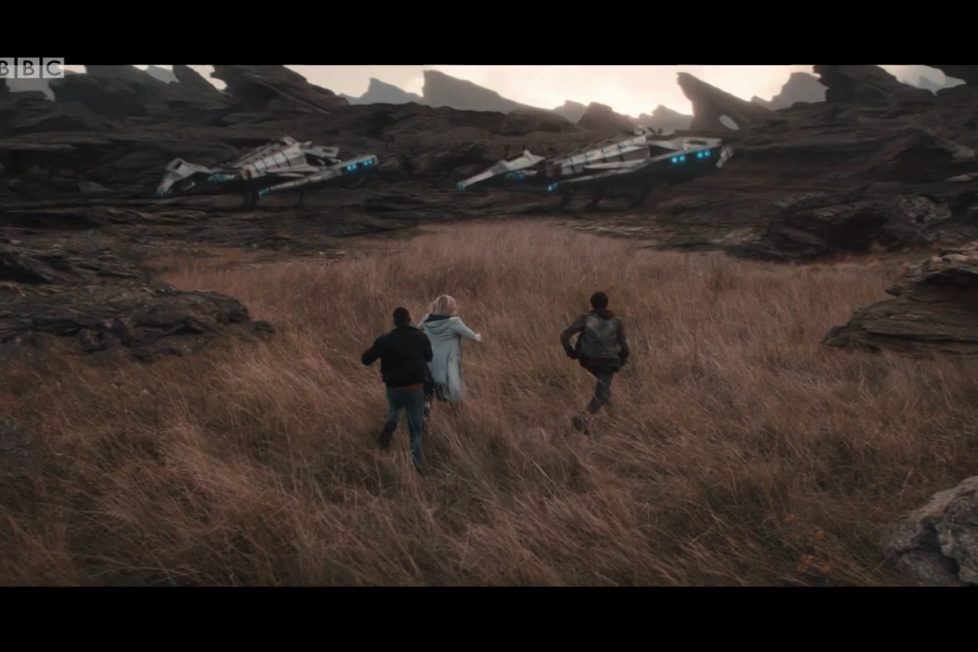
In the far future, the Doctor and her friends face a battle across the farthest reaches of space to protect the last of mankind against the deadly Cybermen.


Like the opening episodes of previous two-part finales, “Ascension of the Cybermen” essentially functions as the set up for “The Timeless Children”, the season’s closing episode lumbered with that oft-used ‘game-changer’ hyperbole. Before we get to the many questions that “Ascension of the Cybermen” raises, let’s take a look at what, in the main, it achieves. Rather like “Utopia”, “The Sound of Drums” and “Last of the Time Lords” 2007 trilogy, it forges a linked narrative with “The Haunting of Villa Diodati.” It will be interesting to see how “The Timeless Children” fits into this framework and whether it can answer some of the plot threads left dangling since “Spyfall” where The Master (Sacha Dhawan) insisted to The Doctor (Jodie Whittaker) that “everything you think you know is a lie.”
For starters, the pre-titles crawl through the dismembered remains of Cybermen in the aftermath of the great Cyber War is a splendid way of introducing us to the significant scale of this story. The dulcet tones of Ashad (Patrick O’Kane), the patchwork Cyberman and avatar for Mary Shelley’s soul searching creature in Frankenstein, informs us that “every empire has its time and every empire falls.” Reading between the lines, perhaps it’s not just the apparent fall of the Cybermen he’s referring to. It’s possible he’s also suggesting that the Time Lords of Gallifrey are no longer the power they were. Given The Master’s bitter retribution on the founding fathers of Gallifrey, all will be revealed. Like the fleshy amalgam of a man galvanised into life in Shelley’s text, Ashad claims “that which is dead can live again in the hands of a believer” as the camera zooms into the dead eyes of a Cyberman’s disembodied head and we transition into the titles. This zealotry indicates that Chris Chibnall wants to show us something different with the Cybermen, suggesting that Ashad was a man who actually welcomed the challenges of his conversion (a religious as well as a physical conversion) and the dichotomies between human and machine, self and other. Even the title of this episode has religious overtones.
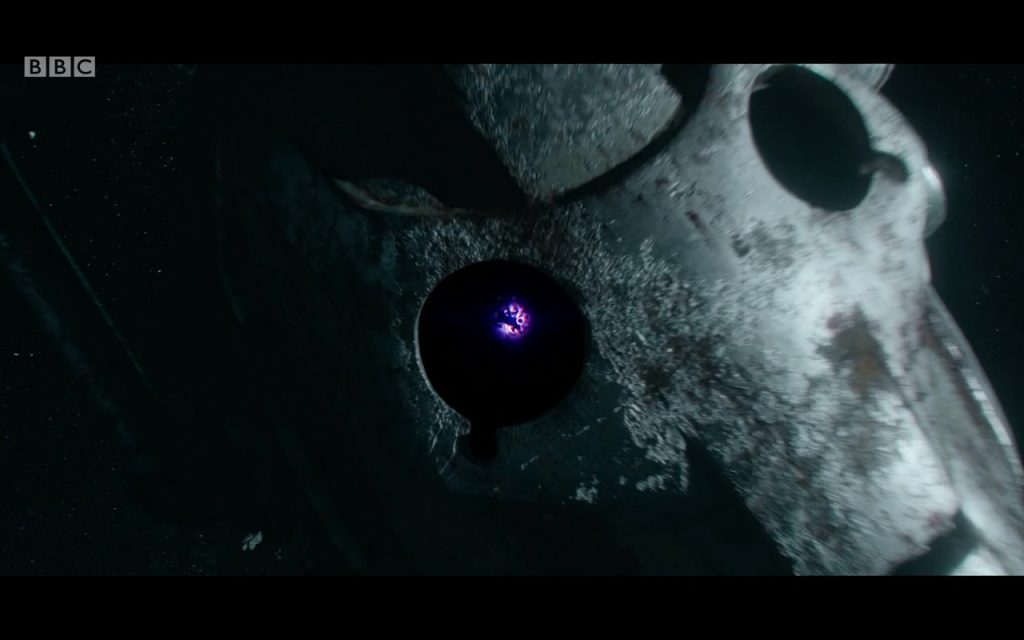
To begin with, two plots intertwine. We have the continuation of the story set in motion at the end of “Diodati” where The Doctor and her companions use Shelley’s chaotic scribblings, while possessed by the Cyberium, to travel into the future where the last humans battle it out with the last of the Cybermen and their leader Ashad has the potential to rebuild the Cyber army and wipe out humanity. Then, to throw us off the scent, we have a B plot. On the surface, it appears to be unrelated to the rest of the story but gradually it starts to provoke several interpretations as to whether this acknowledges the Timeless Child flashbacks we’ve seen or is connected to the ‘ascension’ of the Cybermen in the A plot.
The main action has The Doctor, Yaz (Mandip Gill), Graham (Bradley Walsh), and Ryan (Tosin Cole) arrive on an unnamed planet and offer to help Feekat (Steve Toussaint) defend the last humans “this side of the universe” as Cybershuttles containing the last Cybermen arrive. However, the newly installed neural inhibitors, gold particle projectors and force fields are easily destroyed by Cyberdrones, flying Cyber heads not unlike the Toclafane seen in the aforementioned “The Sound of Drums” and “The Last of the Time Lords”. Certainly, if it’s explosions and stunts you’re after then this sequence provides plenty of them. There’s even a moment of frustration and anger from The Doctor when her companions point out the obvious about the failure of their defences; an anger that motivates her decision to order them to escape with the humans “because you won’t make it back to the TARDIS alive.” She also realises she’s put their lives in jeopardy. If they’re captured they’ll be converted into Cybermen. Is this a foreshadowing of what might happen to one or all of them by the end of “The Timeless Children”?
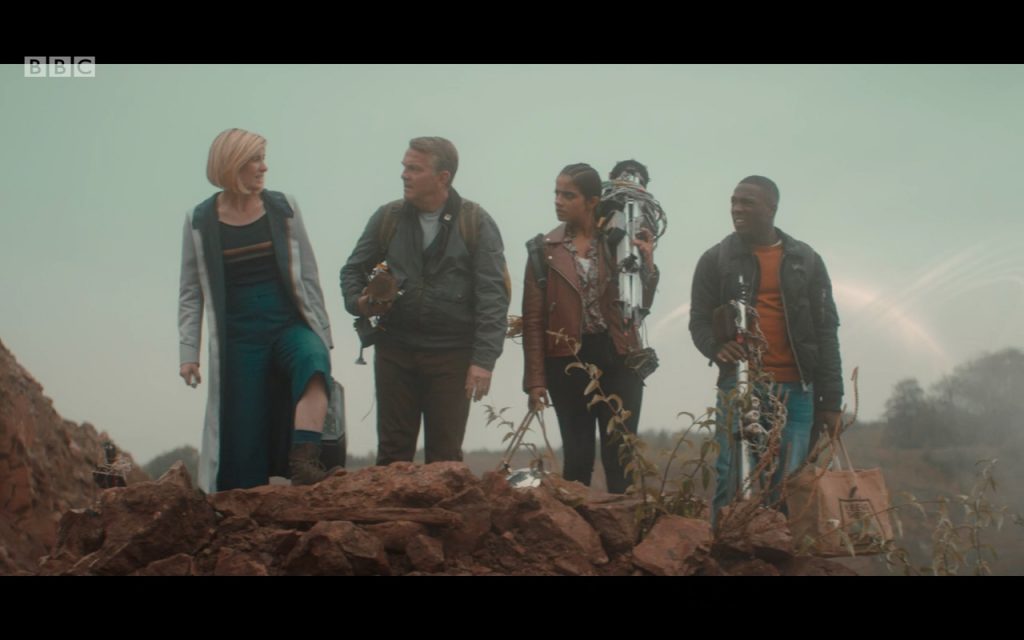
When Ashad and his Cyberguards confront The Doctor, their attempt to “delete” the companions (a vocal nod back to the Cybermen featured in “The Age of Steel” and “The Rise of the Cybermen”) actually splits them up and director Jamie Magnus Stone renders this tense, gritty standoff with a riot of handheld camera shots and rapid cutting. After Feekat is killed by Ashad, Ethan (Matt Carver) is momentarily spared as Ashad considers the potency of evangelical Old Testament mythology, keeping Ethan alive to tell the tale of “my power to every other species” and to “spread my message. Tell them be afraid, all humanity has been erased, all life will fall, and the Cybermen will rise again.” He’s cut off by The Doctor hurling a bomb at him.
Graham and Yaz, accompanying Yedlarmi (Alex Austin) and Bescot (Rhiannon Clements), manage to escape on the Gravraft repaired by Ravio (Julie Graham) while The Doctor, Ryan, and Ethan hijack a Cybershuttle. All share one destination: the Boundary at Ko Sharmus, a portal that will take the humans across the universe and through which the Cybermen cannot follow because, as Ravio claims, “the Boundary patterns are never the same twice.” When the Gravraft goes into meltdown, the survivors believe it’s the end as the ship, powerless and with failing life support, drifts into the “old battlegrounds” and the remnants of a huge space battle, with bits of Cybermen crashing into the hull. The scraps of humanity dying as the scraps of the Cyber race noisily remind them of what they were fighting for is brilliantly visualised in a pullback from Yaz’s viewport into the depths of space littered with bodies. When Yaz and Graham spot a derelict Cyber carrier, they persuade the others to use one last burst of life support energy from the systems to reach it. They eventually get more than they bargained for but surely a landing on a Cyber carrier would have rung alarm bells much earlier with one of them?
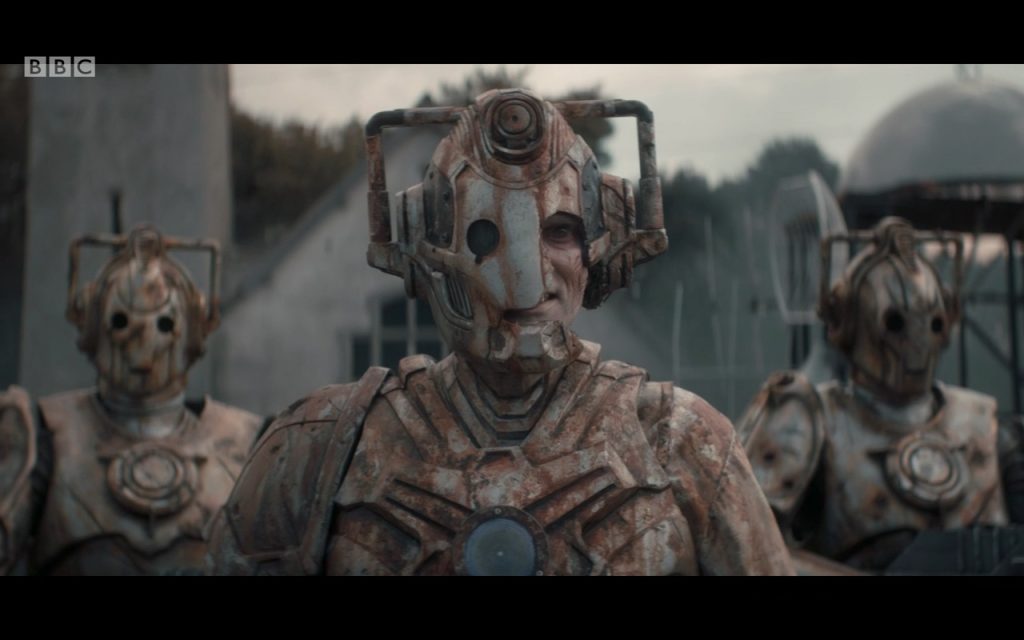
Again, there’s a real sense of scale when the crew of the Gravraft start to explore the abandoned Cyber ship. It’s a cold, vast industrial space (some splendid production design from Dafydd Shurmer) that soon reveals its deadly contents to Ruvio and Graham. There’s some lovely interplay between them, her comment that “I like strange” suggesting a welcome mutual affection, and a effective little moment where Graham’s positive outlook is praised by Yaz in “You’ve come a long way, Graham O’Brien.” They discover thousands of Cybermen in storage just as Ashad and his Cyberguards arrive on board. He sets about their resurrection. As Yedlarmi and Bescot get the ship moving and on course for Ko Sharmus, the Cybermen awake. It’s a barnstorming revival, with stomping lines of Cybermen, evocative of their similar advance in “Earthshock” (1981), on a ship heading straight for Ko Sharmus and the Boundary. Yaz argues that they have little alternative but to keep on course. Even if they change course and land on another world, they’ll let the Cybermen loose there. She promises to keep everyone safe and deal with the Cybermen. Yedlarmi thinks she’s deluded and even Graham, despite his glass-half-full nature, is not entirely convinced.
The Doctor, Ethan and Ryan arrive on Ko Sharmus or, rather, they meet him. Ko Sharmus (Ian McElhinney) is the name of the last human remaining on the planet, guarding the entrance to the Boundary after helping other humans cross through it. A survivor of the Cybercamps, Ko Sharmus shows them the mythical Boundary is actually real. The portal opens and fills the sky as they walk down to a beach. If it looks familiar you may have spotted it in the background of The Doctor’s visions of the Timeless Child, presumably in the sky above Gallifrey.
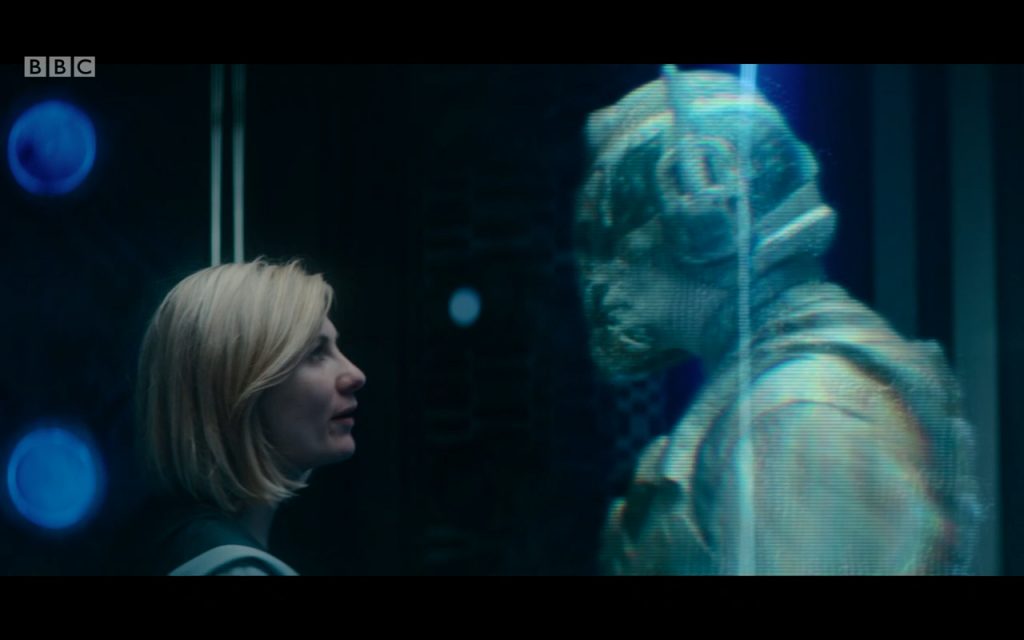
Threaded throughout this action is a very intriguing B plot. A foundling is discovered in the rolling hills of early-20th-century Ireland. Well, we assume it’s Ireland. Given there is no on-screen caption to confirm it, all we have to go on is the twee ‘Irish’ music plonked into the score, the period detail and the accents of the characters. Patrick (Branwell Donaghey) finds a baby boy left in the middle of the lane, lying in a basket swathed in blankets, and after he and his wife Meg (Orla O’Rourke) consult the police and, like the Kents adopting the baby Kal-El in Superman, they eventually bring up Brendan as their own. The orphan or foundling’s fate is often a feature of mythology and fairy tales, where it is often a divine child, the human progeny of a king or a god, whose powers are revealed through some personal epiphany. Ashad is perhaps a Cyber orphan too, struggling out of human innocence to become a post-human monstrosity. I was also struck by the blanket in which little Brendan was wrapped as the patterns on it reminded me of the circular Gallifreyan symbols used throughout the series since 2005.
A montage takes us through his idyllic childhood, from school to childhood illness, always safe in the arms of the never-ageing Patrick and Meg. I did wonder if this was connected to Ashad, especially when the adult Brendan (Evan McCabe) attends an interview for the Irish police force Garda Síochána, translated as ‘the Guardian of the Peace’ and perhaps suggesting several meanings as well as emphasising that this is Ireland. Mind you, there is a running joke about Gallifrey being in Ireland that has popped up before in the classic series and in “Human Nature” (2007) so perhaps Chibnall thought it would be amusing to capitalise on that if, in point of fact, Brendan’s fate turns out to be a Time Lord origin story. Or is this an Ireland that is an embedded hallucination of a Cyberman Brendan awaiting his reactivation?
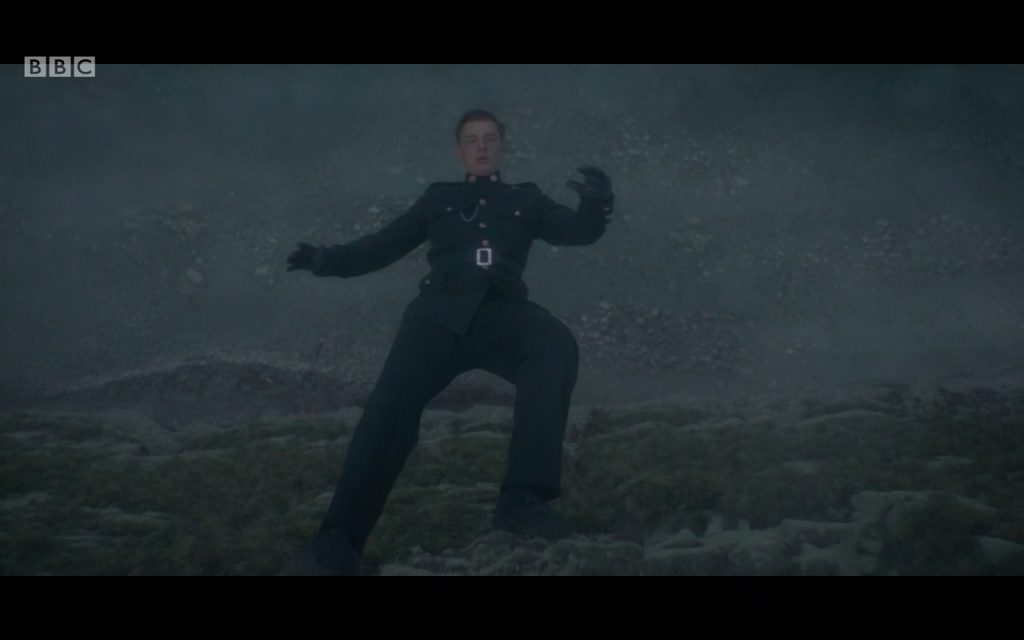
Asked by the sergeant (Coalyn Byrne) why he has applied “to be a guard”, his father prompts “he wants to serve”. His desire to “make a difference” as a recruit aligns with Ashad’s tub-thumping speech to The Doctor on the Cybershuttle: “when the glorious Cyber Empire arrived, I was a willing recruit.” Yet, he was denied his “blessed ascension” (another biblical reference that underlines Ashad’s god-like zeal) and he was rejected for full Cyber conversion. He now sees himself as the chosen one whose task will be to revive the Cyber race. Perhaps this will allow him to prove his worthiness as a recruit for the cause. However, The Doctor only sees “an inner conflict”, between his painful human emotions, his self-hatred, and the driven, emotionless logic of the Cybermen. However, the Cyberium has given him renewed purpose. Quoting Romans 9, where man is described as the perfect vessel for God’s purpose, Ashad states his aim is to ensure “the ascension of the Cybermen and beyond.” Ashad’s vision that “the death of everything is within me” is a very existentialist view worthy of Albert Camus.
Compare this with the following scene where Brendan, now a Garda, chases a thief to a clifftop and, despite reasoning with the man, is shot and seemingly plunges to his death. As in Broadchurch, it seems Chibnall has a thing for clifftop deaths but Brendan survives without a scratch. He holds back death, akin to the immortality bequeathed to a certain Jack Harkness by Rose in “The Parting of the Ways” (2005) via her absorption of time vortex energy. Despite the ambiguity of the plot I started to err towards this as more of a Time Lord origin story. An examination, witnessed by his father and the sergeant, reveals no bullet hole, no broken bones and the newspaper refers to it as a “miracle fall”. It’s a Lazarus motif that could also parallel with Ashad’s power to revive the dead Cyber race.
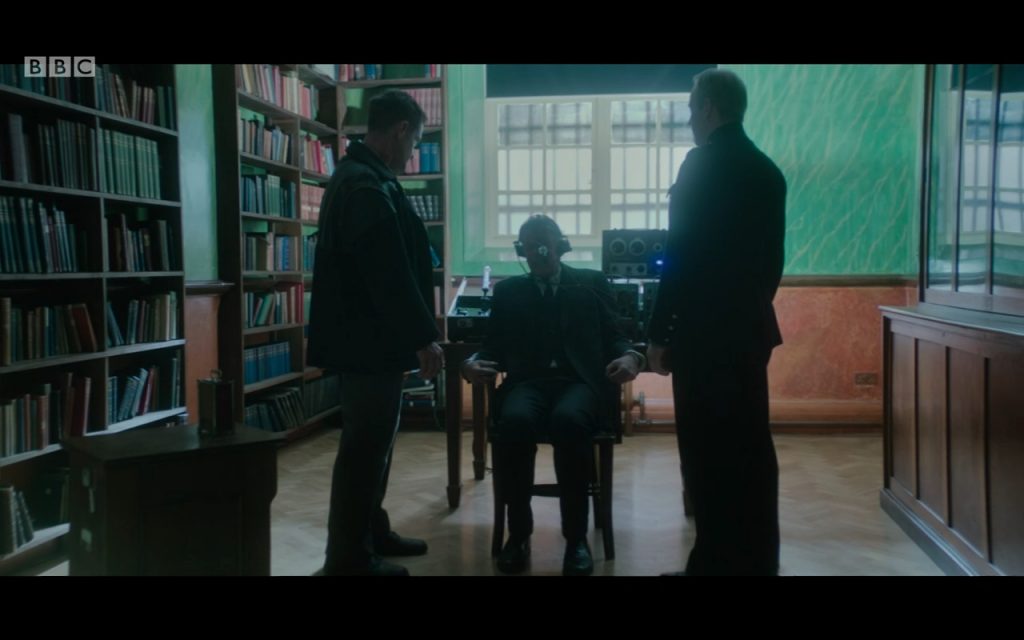
The later scene in the police station is again very curious. It comes just after The Doctor has stepped before the Boundary, its light filling her face. There’s a strange superimposition of mood. As The Doctor stands before the “last way out of this galaxy”, an older Brendan stands before his colleagues and, having earned a peaceful retirement, is presented with a carriage clock for the service he has provided. The clock becomes a focus in the scenes that follow as he leaves the police station and meets his father and the sergeant, who have not aged at all. They force him into a back office. Note that the office doors are very similar to the TARDIS doors. The TARDIS and the office are police boxes. There is a very specific close up of the clock, with the door’s windows in the background. “We have to get rid of everything, I’m afraid,” announces his father as they prepare to wipe his memory. Given the image of the clock and the use of the headset, is this a Time Lord’s essence being transferred to a biodata module in the form of a clock. The last time we saw this, it was the fire alarm that Ruth was compelled to break to release her essence and become The Doctor. Is Brendan now being given a human identity?
It’s interesting how the significance of these scenes contrast with the sequences featuring Ashad. As Brendan is painfully wiped of his memories, the headphones suggesting the helmet of a Cyberman, we may be forgiven for thinking that his pain is connected to the pain being inflicted upon the Cyber warriors by Ashad, the “Cyberman who makes other Cybermen scream” as he commences the revival process on the Cyber carrier. Is this the removal of the emotional inhibitor and an attempt to share his own pain with his troops or vice versa?
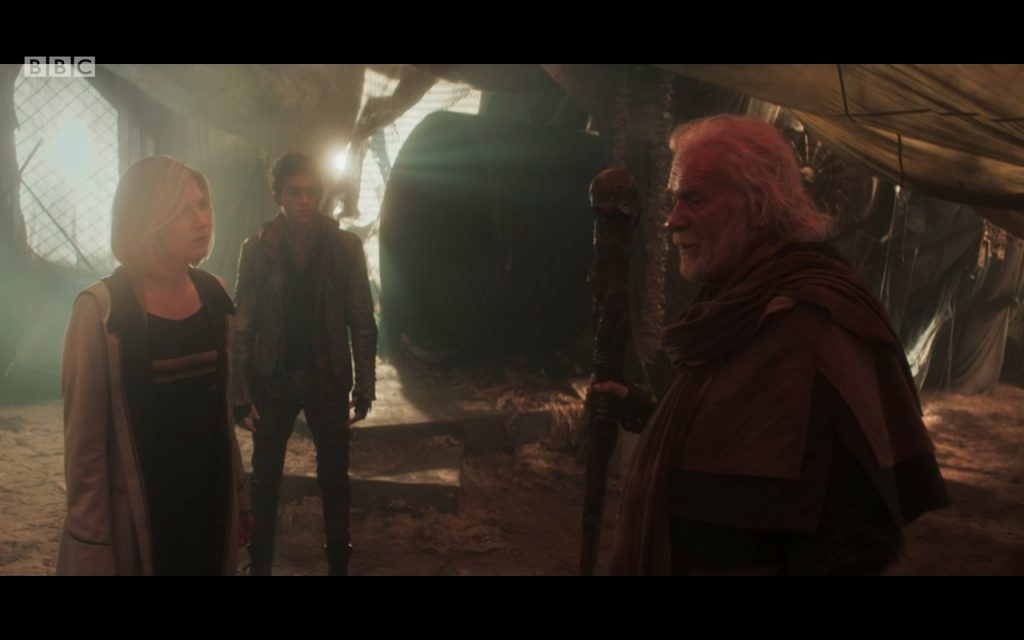
These threads all coalesce into multiple cliffhangers: Yaz, Graham, Ruvio, Yedlarmi, and Bescot trapped on the carrier with thousands of Cybermen closing in on them; Brendan having his identity removed; and The Doctor seeing Gallifrey reappear through the Boundary. This is the Gallifrey she saw in ruins at the end of “Spyfall”. As Ko Sharmus cryptically comments, “I’ve never seen it look like that before” (does he mean Gallifrey or the Boundary?), and the cherry on the cake is, of course, The Master bursting through the Boundary and warning The Doctor that “everything is about to change… forever”. How did he escape the realm of the Kasaavin and how did he engineer his entrance with such accuracy? If this leaves the audience bursting with questions and full of trepidation, then I think “Ascension of the Cybermen” will have fulfilled its purpose as an epic but intriguing hors d’oeuvre before the full-fat, high-calorie impact of “The Timeless Children.”
It also succeeds in making the Cybermen, having had yet another design upgrade, a credible, frightening force after several attempts to do so since the series was revived in 2005. Although Steven Moffat made compelling use of the Mondasian variants and the conversion process truly horrific in his superb “World Enough and Time” (2017), we haven’t seen them this fearsome, en masse, in years. I think we were all expecting The Master to return so it wasn’t entirely surprising to see him linked with the reappearance of Gallifrey. The key will be how to balance the major revelations suggested about the Time Lords with the action-orientated battle against the Cybermen. Given the next episode’s 65-minute running time, I hope those elements can be satisfyingly resolved without the mercy of a cop-out from Chibnall.

writer: Chris Chibnall.
director: Jamie Magnus Stone.
starring: Jodie Whittaker, Bradley Walsh, Tosin Cole, Mandip Gill, Ian McElhinney, Andrew Macklin, Julie Graham, Steve Toussaint, Sacha Dhawan, Orla O’Rourke & Evan McCabe.
